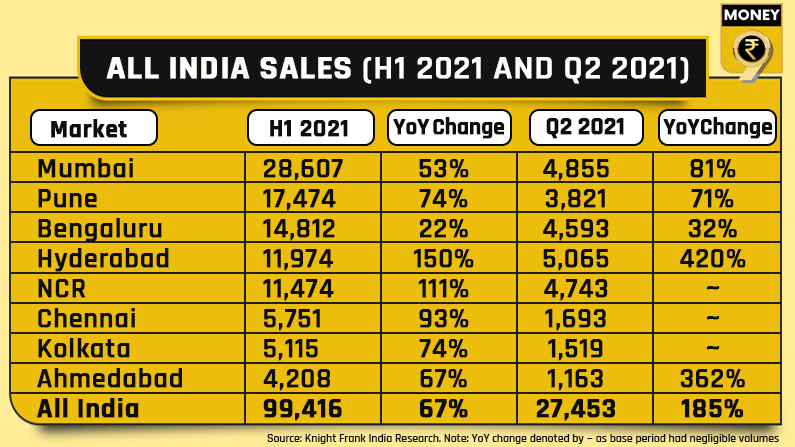Residential sales jump 67% in Jan-June despite second Covid wave: Knight Frank India
In H1 2021, new launches increased by 71% (y-o-y), driven by Mumbai and Pune in Maharashtra

Knight Frank India, a leading international property consultancy, reported overall residential sales of 99,416 units in the first half of 2021 across key markets, while new launches totaled 1,03,238 units during the same period. As sales volumes stabilised, particularly in the early part of 2021, unsold inventories decreased by 1% year-over-year (Y-o-Y). Prices remained largely stable, falling between -1 and -2 % (Y-o-Y).
Second wave impact had a less severe effect on residential real estate
The first half of 2021 saw a 67% year-on-year rise in sales volume, with the January-March accounting for the lion’s share of overall volumes. Throughout the first half of this year, two markets – Mumbai and Pune – had a significant impact on sales volumes, accounting for more than 45% of total sales among major markets. The growth of these two markets was driven on back of the Maharashtra government’s decision to lower stamp duty rates for a limited period.
Similarly, NCR and Hyderabad residential markets also saw a massive growth of 111% and 150% over the first half of 2021 (see table). While home sales began to recover, the pace was stifled by the pandemic’s second wave, which began in late March 2021. Interestingly, the second wave occurred over the same period as the first wave last year, bringing the residential sales market to a grinding standstill. Fortunately, despite its extraordinarily morbid potency, the second wave had a less severe impact on the residential real estate market.

New launches
In H1 2021, new launches increased by 71% (y-o-y), driven by Mumbai and Pune in Maharashtra. Launches increased dramatically across all markets as developers sought to meet strong demand. April-June 2021 accounted for a little more than 1/4 of all launches in the first half of 2021. However, when compared to the previous year’s pandemic-affected quarter, Q2 2021 had a 388% (y-o-y) increase.
“The gradual resumption of economic activity and increasing availability of the vaccine had sparked market traction in the second half of 2020, and this momentum carried over into Q1 2021. The second wave of Covid-19 infections has impeded this momentum but should be seen as more of a speedbump as (Y-o-Y) growth in market volumes remains strong in half-yearly and quarterly terms in the January to June 2021 period,” said Shishir Baijal, chairman and managing director, Knight Frank India.
Lastly, unsold inventory has decreased slightly over the last year, demonstrating a robust increase in sales across all markets. Due to the pandemic’s second phase, these eight markets have shown great promise in terms of consumer appetite. In the future, demand is expected to pick up as the unlocking progresses, and people can proceed to complete their sales process.
“With an aggressive vaccination drive coupled with limited restrictions on businesses, the second wave had less impact on the real estate sector. From real estate standpoint, the reduction in repo rate, stamp duty, ready reckoner rate has been crucial in driving the sales momentum in H2 2020 and Q2 2021. Moreover, post the stamp duty revision, lucrative offers from developers have managed to sustain the momentum. As a result, real estate witnessed historic growth (y-o-y) in the H1 2021,” added Rohit Poddar, managing director, Poddar Housing and Development on Knight Frank’s All India Residential H1 Report.

